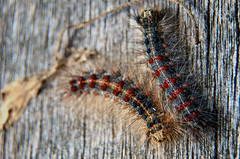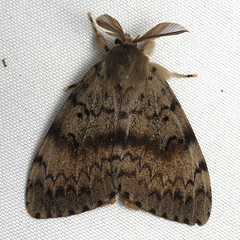 Gypsy moth caterpillars are destructive to trees and shrubs. Each can eat up to one square foot (roughly 900 square cm) of leaves per day!
Gypsy moth caterpillars are destructive to trees and shrubs. Each can eat up to one square foot (roughly 900 square cm) of leaves per day!
Photographer: Dennis WilkinsonA population explosion of gypsy moth (Lymantria dispar) caterpillars can defoliate whole forests of oak or other favored trees.
If a gypsy moth infestation is combined with drought, or if it occurs two or more years in a row, the insects can weaken and indirectly kill many or even most of the oaks in a forest.1
Why does it matter? Gypsy moth defoliation and mortality can create extensive sunlit openings in the forest canopy, allowing understory trees such as red maple to grow.2 When combined with pressures such as heavy browsing of oak seedlings and saplings by deer and the presence of non-native invasive plants, large opening such as these can result in a complete shift in forest canopy composition.
 An adult male gypsy moth.
An adult male gypsy moth.
Photographer: Jenn Forman OrthNational Park Service and U.S. Forest Service staff fight the gypsy moth with insecticides, a naturalized fungus that infects gypsy moth caterpillars, and parasitic wasps.
Oak trees’ natural cycles of heavy acorn production also help prevent gypsy moth overpopulation by giving an occasional boost to mice and other small mammals that feed on this pest.
Gypsy moth caterpillars are hairy and have distinctive markings: five pairs of blue dots on the back near the head, followed by six pairs of red dots.3 They do not build webs, as do the native eastern tent caterpillar and fall webworm which rarely kill trees.4
Native to Europe and Asia, the gypsy moth became established in America in the late 1800s, and reached the mid-Atlantic region a century later.
- 1. . 2003. Gypsy moth in North America.
- 2. . 1998. The red maple paradox: what explains the widespread expansion of red maple in eastern forests? BioScience. 48:355-364
- 3. . 2008. Focus on Plant Problems: Gypsy Moth.
- 4. . 2007. Eastern tent caterpillar. accessed March 3, 2009


